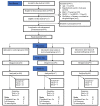Effects of an active break and postural shift intervention on preventing neck and low-back pain among high-risk office workers: a 3-arm cluster-randomized controlled trial
- PMID: 33906239
- PMCID: PMC8091075
- DOI: 10.5271/sjweh.3949
Effects of an active break and postural shift intervention on preventing neck and low-back pain among high-risk office workers: a 3-arm cluster-randomized controlled trial
Abstract
Objective: This study evaluated the effects of the promotion of active breaks and postural shifts on new onset of neck and low-back pain during a 6-month follow-up among high-risk office workers.
Methods: A 3-arm cluster-randomized controlled trial with 6-month follow-up was conducted among healthy but high-risk office workers. Participants were recruited from six organizations in Bangkok, Thailand (N=193) and randomly assigned at cluster level into active break intervention (N=47), postural shift intervention (N=46), and control (N=100) groups. Participants in the intervention groups received a custom-designed apparatus to facilitate designated active breaks and postural shifts during work. Participants in the control group received a placebo seat pad. The primary outcome measure was new onset of neck and low-back pain during 6-month follow-up. Analyses were performed using Cox proportional hazard models.
Results: One-hundred and eighty-six (96%) predominantly female participants were successfully followed up over six months. New onset of neck pain during the 6-month follow-up occurred in 17%, 17%, and 44% of the participants in the active break, postural shift, and control groups, respectively. For new onset of low-back pain, these percentages were 9%, 7%, and 33%, respectively. Hazard rate (HR) ratios after adjusting for biopsychosocial factors indicated a protective effect of the active break and postural shift interventions for neck pain [HRadj 0.45, 95% confidence interval (CI) 0.20-0.98 for active break and HRadj 0.41, 95% CI 0.18-0.94 for postural shift] and low-back pain (HRadj 0.34, 95% CI 0.12-0.98 for active break and HRadj 0.19, 95% CI 0.06-0.66 for postural shift).
Conclusion: Interventions to increase either active breaks or postural shifts reduced new onset of neck and low-back pain among high-risk office workers.
Conflict of interest statement
The authors declare no conflicts of interest.
Figures





Similar articles
-
Effectiveness of a dynamic seat cushion on recovery and recurrence of neck and low back pain in office workers: a secondary analysis of a randomized controlled trial.BMC Musculoskelet Disord. 2024 Oct 25;25(1):850. doi: 10.1186/s12891-024-07947-4. BMC Musculoskelet Disord. 2024. PMID: 39448950 Free PMC article. Clinical Trial.
-
The effects of active break and postural shift interventions on recovery from and recurrence of neck and low back pain in office workers: A 3-arm cluster-randomized controlled trial.Musculoskelet Sci Pract. 2021 Dec;56:102451. doi: 10.1016/j.msksp.2021.102451. Epub 2021 Aug 20. Musculoskelet Sci Pract. 2021. PMID: 34450361 Clinical Trial.
-
The effectiveness of a dynamic seat cushion in preventing neck and low-back pain among high-risk office workers: a 6-month cluster-randomized controlled trial.Scand J Work Environ Health. 2024 Oct 1;50(7):555-566. doi: 10.5271/sjweh.4184. Epub 2024 Aug 22. Scand J Work Environ Health. 2024. PMID: 39169894 Free PMC article. Clinical Trial.
-
Workplace interventions for increasing standing or walking for decreasing musculoskeletal symptoms in sedentary workers.Cochrane Database Syst Rev. 2019 Nov 17;2019(11):CD012487. doi: 10.1002/14651858.CD012487.pub2. Cochrane Database Syst Rev. 2019. PMID: 31742666 Free PMC article.
-
Effect of education on non-specific neck and low back pain: A meta-analysis of randomized controlled trials.Man Ther. 2016 Apr;22:31-41. doi: 10.1016/j.math.2015.10.012. Epub 2015 Nov 2. Man Ther. 2016. PMID: 26585295 Review.
Cited by
-
Hybrid office work in women and men: do directly measured physical behaviors differ between days working from home and days working at the office?Ann Work Expo Health. 2023 Nov 28;67(9):1043-1055. doi: 10.1093/annweh/wxad057. Ann Work Expo Health. 2023. PMID: 37795673 Free PMC article.
-
The Effect of an Active Break Intervention on Nonspecific Low Back Pain and Musculoskeletal Discomfort during Prolonged Sitting among Young People-Protocol for a Randomized Controlled Trial.J Clin Med. 2024 Jan 22;13(2):612. doi: 10.3390/jcm13020612. J Clin Med. 2024. PMID: 38276118 Free PMC article.
-
Poor neck posture and longer working duration during root canal treatment correlated with increased neck discomfort in dentists with <5-years' experience in endodontics.J Occup Health. 2022 Jan;64(1):e12362. doi: 10.1002/1348-9585.12362. J Occup Health. 2022. PMID: 36125183 Free PMC article.
-
Low back pain among the working-age population: from the global burden of disease study 2021.BMC Musculoskelet Disord. 2025 May 5;26(1):441. doi: 10.1186/s12891-025-08704-x. BMC Musculoskelet Disord. 2025. PMID: 40325390 Free PMC article.
-
Effectiveness of a dynamic seat cushion on recovery and recurrence of neck and low back pain in office workers: a secondary analysis of a randomized controlled trial.BMC Musculoskelet Disord. 2024 Oct 25;25(1):850. doi: 10.1186/s12891-024-07947-4. BMC Musculoskelet Disord. 2024. PMID: 39448950 Free PMC article. Clinical Trial.
References
-
- Ehsani F, Mosallanezhad Z, Vahedi G. The prevalence risk factors and consequences of neck pain in office employees. Middle East J Rehabil Health. 2017;4(2):e42031. https://doi.org/10.5812/mejrh.42031.
-
- Areerak K, van der Beek AJ, Janwantanakul P. A health behavior screening tool for non-specific neck pain in office workers:a 1-year prospective cohort study. J Occup Health. 2018 Sep;60(5):410–8. https://doi.org/10.1539/joh.2018-0001-FS. - PMC - PubMed
-
- Ayanniyi O, Ukpai BO, Adeniyi AF. Differences in prevalence of self-reported musculoskeletal symptoms among computer and non-computer users in a Nigerian population:a cross-sectional study. BMC Musculoskelet Disord. 2010 Aug;11(1):177. https://doi.org/10.1186/1471-2474-11-177. - PMC - PubMed
-
- Sitthipornvorakul E, Janwantanakul P, Lohsoonthorn V, Sitthipornvorakul E, Janwantanakul P, Lohsoonthorn V. The effect of daily walking steps on preventing neck and low back pain in sedentary workers:a 1-year prospective cohort study. Eur Spine J. 2015 Mar;24(3):417–24. - PubMed
-
- Hoy D, Bain C, Williams G, March L, Brooks P, Blyth F, et al. A systematic review of the global prevalence of low back pain. Arthritis Rheum. 2012 Jun;64(6):2028–37. https://doi.org/10.1002/art.34347. - PubMed
Publication types
MeSH terms
LinkOut - more resources
Full Text Sources
Other Literature Sources
Medical

